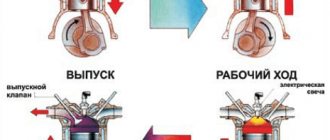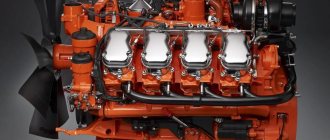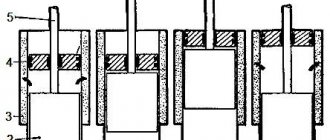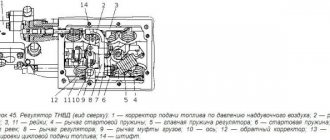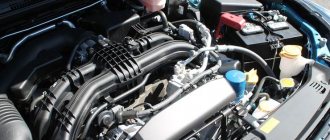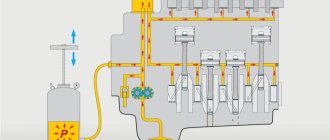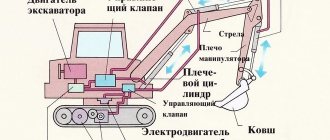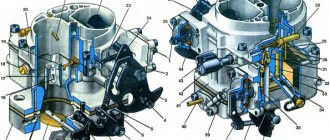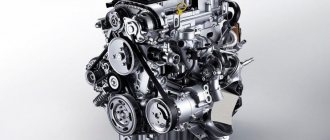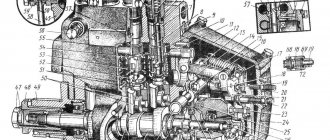Schematic diagram of a two-shaft gas turbine engine with a heat exchanger
Schematic diagram of a two-shaft gas turbine engine with a heat exchanger
Schematic diagram of a gas turbine engine with a free-piston gas generator
Thus, the efficiency of the best turbine models is not inferior to that of diesel engines. It is no coincidence that the number of experimental gas turbine vehicles of various types increases every year. More and more new companies in different countries are announcing their work in this area.
Diagram of a real gas turbine engine
Gas turbines are not installed on passenger cars, primarily due to the constant need to limit the temperature of the gases that enter the turbine blades. As a result, the efficiency of the device decreases and fuel consumption increases.
Design and principle of operation of the unit
The design of the engine is not very complex; it is represented by a combustion chamber, where nozzles and spark plugs are equipped, which are necessary to supply fuel and produce a spark charge. The compressor is equipped on a shaft together with a wheel with special blades.
In addition, the motor consists of such components as a gearbox, an intake duct, a heat exchanger, a needle, a diffuser and an exhaust pipe.
As the compressor shaft rotates, the air flow entering through the intake duct is captured by its blades. After increasing the compressor speed to five hundred m per second, it is pumped into the diffuser. The speed of the air at the outlet of the diffuser decreases, but the pressure increases. Then the air flow ends up in a heat exchanger, where it is heated by exhaust gases, and after that the air is supplied to the combustion chamber.
Along with it, fuel gets there, which is sprayed through the nozzles. After the fuel is mixed with air, a fuel-air mixture is created, which ignites due to the spark received from the spark plug. At the same time, the pressure in the chamber begins to increase, and the turbine wheel is driven by gases falling on the wheel blades.
As a result, the torque of the wheel is transferred to the car’s transmission, and the exhaust gases are released into the atmosphere.
The compressor and turbine are located on the same shaft. Cold air is supplied to cool the combustion products. In modern jet engines, the operating temperature can exceed the melting point of the rotor blade alloys by approximately 1000 °C. The cooling system of turbine parts and the selection of heat-resistant and heat-resistant engine parts are one of the main problems in the design of jet engines of all types, including turbojet ones.
Today, aviation is almost 100% made up of machines that use a gas turbine type of power plant. In other words, gas turbine engines. However, despite the growing popularity of air travel now, few people know how that humming and whistling container that hangs under the wing of this or that airliner works.
The principle of operation of a gas turbine engine.
And now more about the design. The four processes listed above occur in the engine, which is depicted in a simplified diagram under the numbers:
- air intake – 1 (air intake)
- compression – 2 (compressor)
- mixing and ignition – 3 (combustion chamber)
- exhaust – 5 (exhaust nozzle)
- The mysterious section number 4 is called the turbine. This is an integral part of any gas turbine engine, its purpose is to obtain energy from gases that exit the combustion chamber at enormous speeds, and it is located on the same shaft with the compressor (2), which drives it into action.
This creates a closed cycle. Air enters the engine, is compressed, mixed with fuel, ignited, directed to the turbine blades, which remove up to 80% of the power of the gases to rotate the compressor, all that remains determines the final engine power, which can be used in different ways.
Depending on the method of further use of this energy, gas turbine engines are divided into:
- turbojet
- turboprop
- turbofan
- turboshaft
The engine shown in the diagram above is a turbojet. You can say “pure” gas turbine, because the gases, after passing through the turbine that rotates the compressor, exit the engine through the exhaust nozzle at great speed and thus push the plane forward. Such engines are now used mainly on high-speed combat aircraft.
Turboshaft engines are almost identical in design to turboprop engines, except that the shaft, which is connected to the low-pressure turbine, comes out of the engine and can power absolutely anything. Such engines are used in helicopters, where two or three engines drive a single main rotor and a compensating tail propeller. Even tanks such as the T-80 and the American Abrams now have similar power plants.
Gas turbine engines are also classified according to other characteristics:
- by type of input device (adjustable, unregulated)
- by compressor type (axial, centrifugal, axial centrifugal)
- by type of air-gas path (direct-flow, loop)
- by turbine type (number of stages, number of rotors, etc.)
- by type of jet nozzle (adjustable, unregulated), etc.
The compressor and turbine are located on the same shaft. Cold air is supplied to cool the combustion products. In modern jet engines, the operating temperature can exceed the melting point of the rotor blade alloys by approximately 1000 °C. The cooling system of turbine parts and the selection of heat-resistant and heat-resistant engine parts are one of the main problems in the design of jet engines of all types, including turbojet ones.
A special feature of turbojet engines with a centrifugal compressor is the design of the compressors. The operating principle of such engines is similar to engines with an axial compressor.
- turbojet engines (TRD)
- double-circuit turbojet engines (turbojet engines)
- Turboprop engines (TVD)
- Turboshaft engines (TVaD)
Moreover, turbojet engines and turbofans may contain an afterburner, in which case they will be turbofans and turbofan engines, respectively. We will not consider them in this article.
Turboprop engines
A turboprop engine, like a turbojet, is a gas turbine engine. And it works almost like a turbojet. A basic turboprop engine consists of elements already familiar to us: a compressor, a combustion chamber, a turbine and a nozzle. A gearbox and a screw are added to them.
Schematic design of the theater
Schematic design of a turboprop engine with a free turbine
I would like to note that there is no need to look at turboprop engines as an ineffective relic of the past. I have heard such statements several times, but they are not true. In some cases, a turboprop engine has the highest efficiency, as a rule, on aircraft with not very high speeds (for example, 500 km/h), moreover, the aircraft can be of impressive size. In this case, a turboprop engine can be many times more profitable than the previously discussed turbojet engine.
This is where we can finish about turboprop engines. We are slowly approaching the concept of a turboshaft engine.
Powering your potential. Kawasaki is committed to providing customers with unique business solutions using our innovative technologies to meet diverse societal needs around the world. Kawasaki "works as one for the betterment of the planet."
The most basic type of gas turbine is one that creates thrust by a jet stream, and it is also the simplest in design. This engine is suitable for aircraft flying at high speed and is used in supersonic aircraft and fighter jets.
This type has a separate turbine behind the turbojet engine that spins a large fan at the front. This fan increases airflow and draft. This type is low noise and economical at subsonic speeds, which is why gas turbines of this type are used to power passenger aircraft engines.
This gas turbine produces power as torque, with the turbine and compressor sharing a common shaft. Part of the useful power of the turbine is used to rotate the compressor shaft, and the rest of the energy is transferred to the working shaft. This type is used when a constant rotation speed is needed, for example, as a generator drive.
* So, the supply of air, and subsequently the fuel-air mixture. In compressed form, atmospheric air from the compressor enters the combustion chamber. Where the fuel goes, we end up with a fuel mixture that releases a lot of energy during the combustion process.
Operating principle of a gas turbine engine
The maximum pressure is determined by the maximum rotation speed of the turbine blades, which must be achieved in order to obtain the highest value of motor power. As a rule, the smaller the size and weight of the engine, the higher the rotational speed of its shaft, in order to maintain the maximum speed of the turbine blades. This is due to their low inertia - the smaller the gas turbine engine, that is, the gas turbine engine, the greater the shaft rotation - to compensate for the smaller size and weight.
• using the working fluid in a circular process - open and closed systems;
Links
- Foreign aircraft engines. Directory. 2005
- Publications on Aviation and Stationary GTD, Part 1/2 - Avsim.su
- Publications on Aviation and Stationary GTE, Part 2/2 - Avsim.su
- Publications on Aviation and Stationary GTE, Part 3 - Avsim.su
- Aviation engine АШ-82 — Avsim.su
- Illustrated catalog of aircraft engines with their characteristics, descriptions - Avsim.su
- Aviation turbojet engine D-30 III series - Avsim.su
- Feldman E.L. Aviation turbojet engine RD-3M-500 — Avsim.su
- Aircraft engines - Wikipedia
- Piston aircraft engines - Wikipedia
- List of aircraft engines - Wikipedia
- List of aircraft engines of the USSR and post-Soviet countries - Wikipedia
| This is a work in progress. You can help the project by correcting and expanding it. |
Operating principle of a gas turbine engine
A gas turbine engine (GTE) is a type of heat engine whose design includes blade machines. The peculiarity of the work is that the transformation of the energy of burning fuel into mechanical work occurs in it continuously.
In a gas turbine engine, the components of the working cycle, including air compression, heat removal to the working fluid and expansion, are separated from each other and occur in different places.
A gas turbine engine can be used as a heat engine in gas turbine locomotives and aircraft.
A gas turbine engine can operate on any type and grade of fuel (liquid, solid and gaseous).
Today there are many known designs and schemes of gas turbine engines, differing from each other in the following parameters:
• fuel combustion conditions - with internal and external combustion;
• using the working fluid in a circular process - open and closed systems;
• number of shafts - single-shaft, two- and multi-shaft.
Rice. 2. Schematic diagram of a single-shaft gas turbine engine:
1 — gas turbine housing; 2 — gas turbine impeller; 3 - fuel pump; 4 - free shaft; 5— air compressor; 6 — air intake device of the air compressor; 7— electric spark plug; 8— combustion chamber; 9 — guide vane; 10 - gas outlet; II - power consumer; 12 - starting motor
LNG plants typically use low-grade fuel. The turbine runs on gas with a relatively low temperature (500-600 °C), so a less heat-resistant material can be used to make the blades. The efficiency of such installations reaches 35%, but they have increased weight and dimensions compared to diesel engines with gas turbine supercharging.
There are design developments and attempts to create locomotive gas turbine engines using solid or pulverized fuel.
The gas turbine unit is compact, has a low weight per unit of power, does not contain parts with reciprocating motion, which leads to faster engine wear, and is characterized by low equipment maintenance costs. It can operate without consuming water, it is easy to fully automate processes, there is a real possibility for burning various types of fuel in the combustion chamber, and also has a relatively constant torque on the power take-off shaft.
There are three types of gas turbine engines: turbojet, turbojet bypass and turboprop. Let's consider the operating principle of each type of engine.
Turboshaft engine
Hi all! In this article I want to talk about how aviation gas turbine engines (GTE) work. I will try to make this as simple and understandable as possible.
Aviation gas turbine engines can be divided into:
- turbojet engines (TRD)
- double-circuit turbojet engines (turbojet engines)
- Turboprop engines (TVD)
- Turboshaft engines (TVaD)
Moreover, turbojet engines and turbofans may contain an afterburner, in which case they will be turbofans and turbofan engines, respectively. We will not consider them in this article.
Let's start with turbojet engines.
Turbojet engines
This type of engine was created in the first half of the 20th century and began to find widespread use towards the end of World War II. The world's first serial turbojet aircraft was the German Me.262. Turbofan engines were popular until the 60s, after which they began to be replaced by turbofan engines.
Modern photograph of Me-262 taken in 2016
The simplest turbojet engine includes the following elements:
- Input device
- Compressor
- Combustion chamber
- Turbine
- Jet nozzle (hereinafter simply nozzle)
We can say that this is the minimum set for normal engine operation.
Now let’s look at what is needed for what and why.
The inlet device is an expanding* channel in which air is supplied to the compressor and pre-compressed. In it, the kinetic energy of the incoming air is partially converted into pressure.
*hereinafter we will talk about subsonic speeds. At supersonic speed, physics changes, and everything is completely different there.
A compressor is a device that increases air pressure. A compressor can be characterized by a value such as the degree of pressure increase. In modern engines it is already starting to exceed 40 units. In addition, the temperature in it increases (maybe somewhere up to 400 degrees Celsius).
A combustion chamber is a device in which heat is supplied to the compressed air (after the compressor) due to the combustion of fuel. The temperature in the combustion chamber is very high, can reach 2000 degrees Celsius. It may seem to you that the gas pressure in the chamber also increases greatly, but this is not so. Theoretically, it is generally accepted that heat is supplied at constant pressure. In reality, it drops slightly due to losses (the problem of imperfect design).
A nozzle is a tapering channel in which the potential energy of the gas is converted into kinetic energy (the remaining reserve of gas energy after the turbine). As in a turbine, gas expansion occurs in the nozzle. A jet is formed, which, flowing out of the nozzle, moves the plane.
We've sorted out the basic elements. But it’s still not very clear how it works? Then let's do it again and briefly.
This cycle is called the Brayton cycle, or a thermodynamic cycle with a continuous operating process and heat input at constant pressure. All gas turbine engines operate according to this cycle.
Brayton cycle in PV coordinates
N-B - compression process in the inlet device V-K - compression process in the compressor K-G - isobaric heat supply G-T - gas expansion process in the turbine G-S - gas expansion process in the nozzle C-H - isobaric heat removal in atmosphere
Schematic design of a turbojet engine, where 0-0 is the engine axis
A turbojet engine can have two shafts. In this case, the compressor consists of a low-pressure compressor (LPC) and a high-pressure compressor (HPC), and the work supply will be carried out by a low-pressure turbine (LPT) and a high-pressure turbine (HPT), respectively. This scheme is more favorable gasdynamically.
Cutaway view of a real engine of this type
We examined the operating principle of the simplest aircraft gas turbine engine circuit. Naturally, modern Airbuses and Boeings are equipped with turbofan engines, the design of which is noticeably more complex, but everything works according to the same laws. Let's look at them.
Double-circuit turbojet engine
Schematic design of a twin-shaft bypass turbojet engine
One of the most important characteristics of a turbofan engine is the bypass ratio. The bypass ratio is the ratio of air flow in the outer loop to air flow in the inner loop. This number can be either greater or less than one. On modern engines this number exceeds 12 units. Engines with a bypass ratio of more than two are usually called turbofan engines, and the first stage of the compressor (the one that operates on both circuits) is called a fan.
Boeing 757-200 turbofan engine. The input device and fan are visible in the foreground.
On some engines, the fan is driven by a separate turbine, which is placed closest to the internal circuit nozzle. Then the engine turns out to be three-shaft. For example, Rolls Royce RB211 engines (installed on L1011, B747, B757, B767), D-18T (An-124), D-36 (Yak-42) engines are made according to this design.
D-18T in section from the inside
The main advantage of a turbofan engine is the ability to create high thrust and good efficiency compared to turbojet engines.
With this I would like to finish about the turbofan engine and move on to the next type of engine - the turbofan engine.
Turboprop engines
A turboprop engine, like a turbojet, is a gas turbine engine. And it works almost like a turbojet. A basic turboprop engine consists of elements already familiar to us: a compressor, a combustion chamber, a turbine and a nozzle. A gearbox and a screw are added to them.
Schematic design of a turboprop engine with a free turbine
I would like to note that there is no need to look at turboprop engines as an ineffective relic of the past. I have heard such statements several times, but they are not true. In some cases, a turboprop engine has the highest efficiency, as a rule, on aircraft with not very high speeds (for example, 500 km/h), moreover, the aircraft can be of impressive size. In this case, a turboprop engine can be many times more profitable than the previously discussed turbojet engine.
This is where we can finish about turboprop engines. We are slowly approaching the concept of a turboshaft engine.
Turboshaft engine
Schematic design of a turboshaft engine
TV3-117 engine from the Mi-8 helicopter. The exhaust pipe and drive shaft are visible on the right
So, we looked at four types of gas turbine engines. I hope my text was clear and useful for you. You can write all questions and comments in the comments.
According to the classification, the power plant belongs to thermal devices, since it transforms the released pressure from combustion into mechanical work. In contrast to a unit with pistons, the transformation taking place flows in a continuous gas stream, and this affects the design and operation. Attempts to install a gas turbine engine on cars are constantly being made, but the idea has not received mass development.
Basic properties of fuel used in gas turbines
Depending on the operating conditions of the turbines, fuel for gas turbines is divided into fuel for stationary and jet engines.
For stationary engines, two types of fuel are offered: TGVK (highest category) and TG (regular).
Jet fuel comes in two types:
- For devices with subsonic speed (TI, TS-I, TS-2CM, PT).
- For devices with supersonic speed (T-5, T-6, T-8).
RT fuel can be used as a universal fuel, and T-1 should be replaced.
Jet fuels (aviation paraffin) are paraffin fractions of primary distillation with a boiling point of 150-195 C. Such fuel must have good volatility, high calorific value and thermal stability. Jet fuels differ from TGAC and TG fuels by their reduced sulfur content.
The following specific requirements for jet fuel are noteworthy: minimum density, maximum calorific value, maximum light fractions content and minimum vapor pressure. Abroad, all jet fuels for military and civil aviation are divided into three types:
- wide-fraction composition with a boiling range 60-30050C,
- Kerosene with a boiling range of 70-30000C,
- Kerosene with a high flash point (600C), intended for gas turbine engines on ships.
In addition, all types of fuel contain antioxidants, anti-corrosion substances, anti-icing additives, etc.
Illuminating kerosene is an oil fraction that boils primarily in the range of 200-2800 C, used as solvents, fuel, for washing parts and small arms. The purpose is as follows: KO-30 - Kerosene for lighting, the number indicates the height of the non-flammable flame in mm,
Distinctive features
As mentioned earlier, attempts were made to use a gas turbine engine for a car, but things did not go further than testing. The only industry in which the unit has found application is aviation.
If we compare a gas turbine engine with other power plants, then the first product has a higher power output relative to its weight. There is also a plus in the fuel used, brought to a finely dispersed state, the range imagines, the main type is kerosene and diesel. But it is possible to use: gasoline, gas, alcohol, fuel oil, coal dust, etc.
A unit with pistons and a gas turbine unit are motors that operate on the basis of heat, converting the energy released during combustion into mechanical work. The difference between devices lies in the process. In both engines, air is taken in and compressed, after which a portion of fuel is supplied, then the substance burns, increases and is released into the atmosphere.
In piston installations, the described actions occur at one point - the combustion chamber, and the order of actions is observed. A gas turbine engine is characterized by actions occurring in several parts of the mechanism simultaneously.
To understand how a gas turbine engine works, we separate the stages of processes that together amount to the conversion of fuel into work:
- Supplying fuel and forming a mixture.
Due to the passage of atmospheric air through the compressor wheel, the mixture is compressed in volume, increasing the pressure up to forty times. Afterwards, air flows into the burning volume, where fuel is supplied. Mixing with the air mass and burning, the mixture is energetically transformed.
- Energy operational transformation.
The released force is reformatted into mechanical work. To do this, use special blades that rotate in a gas stream that comes out with pressure.
- Distribution of force.
Distributing the work received, they use a piece of it to compress the next portion of air, the remaining power is allocated to drive the mechanism.
Diagram of turbine inclusion in the process:
Every year the Neftegaz exhibition
. The event is dedicated to the oil industry; it is the largest exhibition in this field.
Gas turbine engines in industry
Gas turbine engines are also actively used in oil production and refining. A gas turbine engine is a complex installation - it is thermal equipment inside which gas is compressed, then heated, and then the energy of the compressed and heated gas creates rotation of the turbine. Such engines are better than piston engines, since all processes in them are more efficient due to the fact that they occur in a flow of moving gas.
The principle of operation of a gas turbine engine is that air is supplied from the compressor to the combustion chamber, then fuel is supplied there. Various types of gaseous products are formed in the combustion chamber and are under pressure. After this, in the engine turbine, the energy of the gaseous products creates mechanical work, and the turbine begins to rotate. The useful work of the engine is the work that is performed by the driven unit.
The advantage of a gas turbine engine is that it has the highest power, it can reach 6 kW/hour. This is the highest figure among analogues. In addition, such a unit is capable of working with different types of fuel - gasoline, kerosene, fuel oil, natural gas, alcohol or crushed coal. This equipment is widely used in oil and gas production.
The cost of gas turbine units is high, but if you take a closer look at these units and their technical characteristics, it is worth considering our advantageous offer.
Requirements for fuel quality for gas turbines
Gas turbines can operate on both gaseous and liquid fuels. This feature makes gas turbine power plants more reliable and flexible, especially in conditions of autonomous power supply. The ability to operate on dual or triple fuel can be structurally implemented in one gas turbine unit. Distillates, products of distillation of crude oil, are used as fuel in gas turbines (GOST 10433-75).
The following types of fuel can be used in gas turbines:
- natural gas
- liquefied gas;
- gas oil
- distillates;
- paraffin;
- gas associated with crude oil;
- biogas (gas from waste, sewage and landfills);
- firedamp;
- wood gas, etc.;
Fuel for gas turbine engines, jet fuel, is usually obtained from low-sulfur oils, the paraffinic (naphtha) fractions of which are rich in naphthenic and aromatic hydrocarbons. Main indicators of jet fuel: density - 780-850 kg/m3 (at 20 °C), viscosity - 1.2-4.5 mm2/s (at 20 °C), flash point - 28-72 °C, calorific value — 43 MJ/kg.
Depending on the chemical composition and method of purification of the oil from which kerosene is obtained, it contains:
- saturated aliphatic hydrocarbons - 20-60%;
- naphthenic - 20-50%; - wood gas
- bicyclic aromatic 5-25%;
- unsaturated - up to 2%;
- impurities in the form of sulfur, nitrogen or oxygen compounds.
Historical reference. Industrial production of kerosene was first started in Russia in 1823 by the Dubinin brothers near Mozdok (300 tons/year; former trade name “photogen”). In the 19th century, only kerosene was used from oil distillation products (for lighting), and the resulting gasoline and other petroleum products had very limited use. For example, gasoline was used for pharmaceutical and veterinary purposes and as a household solvent.
Oil producers simply burned large quantities of kerosene in pits or poured it into reservoirs. In 1911, kerosene finally lost its leading position to oil in the world oil market due to the spread of internal combustion engines and electric lighting. It was only in the 1950s that kerosene regained its importance thanks to the development of jet and turboprop aircraft (aviation kerosene), for which this special type of petroleum product proved to be an almost ideal fuel.
There are several types of kerosene:
- fuel for gas turbine engines;
- tractor and lighting;
- industrial

